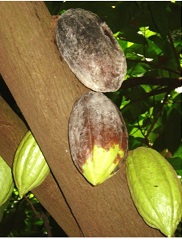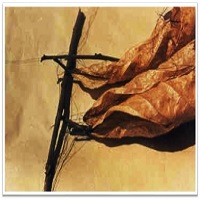DISEASES OF COCOA
Global crop loss due to diseases in cocoa has been estimated to be 21%. The threat of two invasive fungal diseases caused by Phytophthora and Moniliophthora continue to be of global concern. Witches' broom disease (WB) and Ceratocystis wilt disease are serious in Latin American countries causing upto 60% yield loss. These diseases are yet to appear in India. The important diseases in India are described below:
1. Phytophthora pod rot
Causal organism: Phytophthora palmivora, P. capsici, P. megakarya and P. citrophthora)
Very serious during rainy seasons. Infection appears as minute translucent water-soaked spots on the pod surface which turn chocolate brown, darken and increase in size.
Ultimately, the whole pod becomes completely black. The beans in a ripe pod may escape partially or wholly from infection as the beans get separated from the pod husk on ripening.

Blackened pods due to phytophthora infection on pods
Management:
Periodic removal and destruction of the infected pods will help to reduce spread of the disease.
Cultural practices like proper pruning and regulating the overhead shade to reduce relative humidity and to improve aeration have been recommended for the control of the disease.
2. Botryodiplodia pod rot/charcoal pod rot
Causal organism: Lasiodiplodia theobromae, Botryodiplodia theobromae
This pod rot occurs more frequently during the dry season. Symptoms initially appear as pale yellow spots on the pods, which enlarge into chocolate brown larger lesions. Infected pods become mummified and remain attached to the plant.

Charcoal pod rot infection on pods
Management:
Use of Rovral (Iprochone) 2000 ppm at monthly intervals for six months during the dry season is the suggested control measure.
Since the fungus is a wound pathogen, spraying of 1% bordeaux mixture along with an insecticide will also be useful.
3. Vascular streak die back
Causal organisam: Oncobasidium theobromae
Vascular streak die back is a destructive disease of cocoa which may occur on the main stem of a seedling or on a branch of an older tree. The first symptom is the yellowing of second or third leaf behind the growing tip with the development of green spots or islets scattered over a yellow background. The infected leaves fall off within a few days and subsequently, the leaves above and below turn yellow and are shed, resulting in a distinctive situation where the leaves on the middle portion of the shoot fall.


Yellowing of leaves and Infection seen on stem as the disease progresses
Management: Developing genetic stocks resistant to VSD can control the pathogen in the long run. Cultivars of Upper Amazon and Trinitario origin are, in general, less susceptible than Amelonado or its hybrids.
4. Phytophthora canker
Causal organism: Phytophthora palmivora (Butler) Butler
The external symptom appears as greyish brown water-soaked lesions with broad dark brown to black margin on the bark. A reddish brown liquid oozing out from such lesions dries up and forms a rusty deposit. When canker girdles the stem, dieback occurs. Leaves wilt, turn yellow and fall off. Pods also show wilting. Finally, the whole tree dies.


Infection seen on stem and ultimately drying up of plant due to Canker infection
Management: If detected early, remove the affected tissues and apply bordeaux paste, difolatan or any copper based fungicide. Cut and remove the infected small branches. Proper measures of control of Phytophthora pod disease will also help in reducing the canker incidence.
5. White thread blight
Causal organism: Marasmiellus scandens (Massee) Dennis and Reid
The young branches of infected plants contain white mycelial threads of the fungus which spread longitudinally and irregularly along the surface of the stem. Under high humid conditions, the fungus grows very rapidly on the stem and enters the leaf at the nodes through the petiole.

Thread blight infection (mycelial threads of the fungus observed)
Management: Severity of the disease can be reduced by proper shade regulation, removal of affected parts and permitting better aeration through the canopy. In severe cases of infection, spraying of copper fungicides will be helpful.
6. Horse hair blight
Causal organism: Marasmius equicrinos Muell.
Young branches of the affected plants are found to be ramified with tangles of the black hair-like growth of the fungal mycelium. The black branched mycelial network of the fungus spreads over the leaves, petioles and twigs.

Drying up of tig due to fungal attack in horse hair blight disease
Management: Removal and destruction of the affected parts are quite useful
7. Cherelle wilt
Causal organism: Colletotrichum gloeosporioides
The shrivelling and mummifying of some young fruits are a familiar sight in all cocoa gardens. In the early stages, the fruits lose their lusture and in four to seven days they shrivel. The fruits may wilt but do not abscise. Many other factors like insects, diseases, nutrient competition and overproduction may also be associated with this problem. Hence, remedial measures will depend upon the nature of the causative factors involved.

Shriveling and mummifying of young fruits- main symptom observed
8. Pink disease
Causal organism: Corticium salmonicolor Berk and Br.
The disease generally affects the fan branches and small twigs. The first indication of the disease is the death of the branch. Fine white silky mycelia of the fungus get spread over the surface and into the cortex of the bark before the appearance of visible external symptom. This leads to the defoliation and death of the distal part of the branch.
Management: Removal and destruction of the infected branches and sealing the cut end with Bordeaux paste will check the disease. Removal of excess shade and provision of adequate drainage are important for better control of the disease.
PESTS OF COCOA
Affected by over 1500 insects/Non insect pests all over the world. Yield loss as high as 30- 40% in global production. In India, the number of insects causing damages are quite low ( <50) but damages are prominent.
A. Insect Pests
1. Tea mosquito bug
Scientific name: Helopeltis antonii, Helopeltis theivora and H.bradyi
The pest mainly attacks the pods, sometimes young stems and leaves. Circular water-soaked spots develop on the infested pods around the feeding punctures. These punctures later turn black. Multiple feeding injuries cause deformation of the fruits. Reported to be very serious in the Idukki and Kottayam districts of Kerala.

Tea Mosquito damage on cocoa pods
Management: Removal/ Weeding during pre and post monsoon periods
Regular pruning and shade regulation- Proper penetration of sunlight inside the field
Spraying Actara 2g/10litre or Oberon 1ml/litre
2. Red borer
Scientific name: Zeuzera coffeae
The borer mainly attacks mainly young plants. Larvae bore into thick shoots and into the main stem below the first jorquette along the centre and cut a transverse tunnel before pupation. Small lateral galleries with openings are seen at intervals of about 25 cm on the stem.

Red borer infestation on cocoa plants
Management: Spray Neem oil @ 5-10 ml / l of water on the stem- Acts as a repellent.
Spray Raksha (Neem garlic soap emulsion) @ 6g/l of water
Insecticide application of Chlorantraniliprole 18.5 SC @ 3 ml/10 litre or Flubendiamide @ 2 ml/ 10 litre
3. Mealy bug
Scientific name: Planococcus lilacinus
Nymphs and adults occur in colonies and infest growing shoots, terminal buds, flower stalks and pods and start sucking the sap. The visible symptom will be seen as sunken patches in developing pods. This ultimately leads to brown patches, irregular cracks, and pits on mature pods.

Mealy bug infesting growing shoots
Management: Spot application of Neem oil suspension of 2 percent may be sprayed on pods and foliage at the early stage of infestation. In severe cases, spray Actara 2g/10 litre or Imidacloprid 0.5 ml/litre after the first round of soap solution spray and repeat at fortnightly intervals.
4. Grey weevil
Scientific name: Myllocerus spp.
The peak periods of infestation occur during July- September. Infestation is severe on the young plants for up to two years. Adults occur in groups on the underside of the leaves and feed on the green matter leaving the veins intact. The flaccid young leaves are generally not affected. The entire foliage will be badly skeletonized causing retardation of growth.

Myllocerus spp. damage
Management: Spraying may be concentrated on the undersurface of the leaves.
Can be controlled by prophylactic spraying of 0.01% Lambda cyhalothrin or Cypermethrin.
Application of the insecticide may be done twice a year, once during May and again in September.
B. Non- insect Pests
1. Striped squirrels
Scientific name: Funambulus tristriatus
They cut irregular holes on walls of the maturing pods They feed on the mucilaginous pulp around the beans. Continuous trapping using attractants and poison baiting will be effective in checking the population.


Management: As the squirrels damage ripe fruits only, damage can be reduced by harvesting mature pods at regular intervals. Mechanical protection of the pods by covering them with punched polybags (150 gauge) smeared with bitumen - bitumen-kerosene mixture can also be partially effective.
2. Rats
Scientific name: Rattus rattus
The nature of damage is similar to that caused by squirrels. The holes made on the pods are surrounded by areas of endocarp exposed by scraping the fleshy portions of the pods. Rats also prefer pods in the post-bronzing stage for feeding.


Management: Harvesting the pods at the right stage when the furrows start bronzing will reduce damage considerably.
Baiting with rodenticides in the garden is recommended. Rain proof preparations are preferred.
Field traps with coconut pieces can also be used.
Application of rat poison Bromadiolone cake: 10 grams to be applied twice within 10-12 days.




